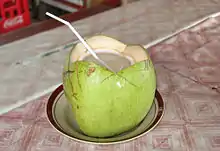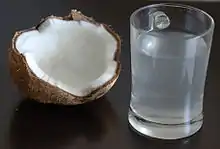Coconut water
Coconut water, less commonly known as coconut juice, is the clear liquid inside coconuts (fruits of the coconut palm). In early development, it serves as a suspension for the endosperm of the coconut during the nuclear phase of development. As growth continues, the endosperm matures into its cellular phase and deposits into the rind of the coconut pulp.[1] The liquid inside young coconuts is often preferred to the liquid of a ripened coconut. Coconut water from young green coconuts is also known specifically as buko juice in Philippine English.[2]


Harvesting
Fresh coconuts are typically harvested from the tree while they are green. A hole may be bored into the coconut to provide access to the "meat" (liquid and pulp). In young coconuts, the liquid and air may be under some pressure and may spray slightly when the inner husk is first penetrated. Coconuts that have fallen to the ground are susceptible to rot and damage from insects or other animals.
Products
Plain coconut water has long been a popular drink in tropical countries, where it is available fresh, canned, or bottled.
Coconuts for drinking are served chilled, fresh, or packaged. They are often sold by street vendors who cut them open with machetes or similar implements in front of customers. Coconut water for retail can be found in ordinary aluminum cans, Tetra Paks, glass bottles or plastic bottles, sometimes with coconut pulp or coconut jelly included.
Coconut water can be fermented to produce coconut vinegar. It is also used to make nata de coco, a jelly-like food.
Nutritional value
| Nutritional value per 100 g (3.5 oz) | |
|---|---|
| Energy | 79 kJ (19 kcal) |
3.71 g | |
| Sugars | 2.61 g |
| Dietary fiber | 1.1 g |
0.20 g | |
| Saturated | 0.176 g |
| Monounsaturated | 0.008 g |
| Polyunsaturated | 0.002 g |
0.72 g | |
| Tryptophan | 0.008 g |
| Threonine | 0.026 g |
| Isoleucine | 0.028 g |
| Leucine | 0.053 g |
| Lysine | 0.032 g |
| Methionine | 0.013 g |
| Cystine | 0.014 g |
| Phenylalanine | 0.037 g |
| Tyrosine | 0.022 g |
| Valine | 0.044 g |
| Arginine | 0.118 g |
| Histidine | 0.017 g |
| Alanine | 0.037 g |
| Aspartic acid | 0.070 g |
| Glutamic acid | 0.165 g |
| Glycine | 0.034 g |
| Proline | 0.030 g |
| Serine | 0.037 g |
| Vitamins | Quantity %DV† |
| Thiamine (B1) | 3% 0.030 mg |
| Riboflavin (B2) | 5% 0.057 mg |
| Niacin (B3) | 1% 0.080 mg |
| Pantothenic acid (B5) | 1% 0.043 mg |
| Vitamin B6 | 2% 0.032 mg |
| Folate (B9) | 1% 3 μg |
| Choline | 0% 1.1 mg |
| Vitamin C | 3% 2.4 mg |
| Minerals | Quantity %DV† |
| Calcium | 2% 24 mg |
| Copper | 2% 0.04 mg |
| Iron | 2% 0.29 mg |
| Magnesium | 7% 25 mg |
| Manganese | 7% 0.142 mg |
| Phosphorus | 3% 20 mg |
| Potassium | 5% 250 mg |
| Selenium | 1% 1 μg |
| Sodium | 7% 105 mg |
| Zinc | 1% 0.10 mg |
| Other constituents | Quantity |
| Water | 95 g |
| |
| †Percentages are roughly approximated using US recommendations for adults. | |
Providing 79 kilojoules (19 kilocalories) of food energy in a 100-millilitre (3 1⁄2-US-fluid-ounce) amount, coconut water is 95% water and 4% carbohydrates, with protein and total fat content under 1% each (table). Coconut water contains small amounts of vitamins and dietary minerals, all under 10% of the Daily Value (DV).
Risks
One health risk arising from excessive consumption of coconut water is an overabundance of potassium in the blood (hyperkalemia), inducing acute kidney failure, heart arrhythmia, loss of consciousness and eventually death.[3][4] Hyperkalemia and loss of consciousness after the consumption of several liters of coconut water were reported only as a clinical case study in association with one individual's use of a commercial product following physical exertion.[4]
The Food and Drug Administration has identified a risk of bacterial contamination in coconut water sold as "raw".[5]
Anecdotal sources describe coconut water being used in southern part of India for senicide, the killing of elderly people, a procedure known as thalaikoothal.[6] In this custom, the elderly person is made to drink an excessive amount of coconut water, eventually resulting in fever and death, the exact causes of which were not determined.[6]
Commercialization
Since the early 21st century, coconut water has been marketed in Western countries as a natural energy or sports drink having low levels of fat, carbohydrates, and calories, and significant electrolyte content.
False advertising
Marketing claims attributing health benefits to coconut water are not based on science and are disallowed by certain regulatory agencies like the United States Food and Drug Administration which warned producers about misleading marketing claims that coconut water is antiviral, can lower cholesterol, can regulate blood glucose levels, and other false claims, as inappropriate for the product.[7][8]
Some companies have faced class action lawsuits over false advertising claims that the product was "super-hydrating", "nutrient-packed", and "mega-electrolyte".[9] The plaintiffs also alleged that one company, Vita Coco, falsely claimed that its product had "15 times the electrolytes found in sports drinks" and misrepresented the levels of sodium and magnesium as advertised. The company denied any wrongdoing and settled the lawsuit for US$10 million in April 2012.[9]
Medical use in Cambodia
Although substituting coconut water for saline is not recommended by physicians today, it was a common practice during the Khmer Rouge regime in Cambodia from 1975 to 1979.[10][11] The Documentation Center of Cambodia cited the practice of allowing untrained nurses to administer green coconut water during the Pol Pot regime as a crime against humanity.[12]
Folk medicine
Coconut water has been used in the folk medicine practices of Jamaica for such uses as the treatment of diarrhea.[13]
References
- Janick J, Paull RE (2008). Cocos in The Encyclopedia of Fruit and Nuts. pp. 109–113. ISBN 9780851996387. Archived from the original on 18 May 2015. Retrieved 11 May 2015.
- Chanco, Boo (16 September 2009). "Buko juice: The next big thing!". PhilStar Global. Retrieved 19 April 2020.
- Rees, Richard; Barnett, Joe; Marks, Daniel; George, Marc (September 2012). "Coconut water-induced hyperkalaemia". British Journal of Hospital Medicine. 73 (9): 534. doi:10.12968/hmed.2012.73.9.534. PMID 23124410.
- Hakimian, J; Goldbarg, SH; Park, CH; Kerwin, TC (2014). "Death by coconut". Circulation: Arrhythmia and Electrophysiology. 7 (1): 180–181. doi:10.1161/CIRCEP.113.000941. PMID 24550410. Archived from the original on 2015-05-23.
- Martinez-Belkin N (2 December 2014). ""Raw" Coconut Water Under Scrutiny of the FDA". BevNet.com. Archived from the original on
|archive-url=requires|archive-date=(help). - Shahina, KK (2010-11-20). "Mother, shall I put you to sleep?". Tehelka Magazine. 7 (46). Archived from the original on 2014-04-29. Retrieved 2014-06-01.
- Martinez-Belkin N (2 December 2014). ""Raw" Coconut Water Under Scrutiny of the FDA". BevNet.com.
- Crawford, Elizabeth (October 29, 2014). "Coconut products can never claim to be 'healthy' because of the saturated fats, says legal expert". foodnavigator-usa.com. Archived from the original on 10 February 2016. Retrieved 31 December 2015.
- "Vita Coco coconut water settles class action lawsuit". Lexology. Manatt Phelps & Phillips LLP. May 27, 2012. Archived from the original on 4 March 2016. Retrieved 31 December 2015.
- Barclay, Eliza (15 Aug 2011). "Coconut Water To The Rescue? Parsing The Medical Claims". NPR. Archived from the original on 2013-09-27. Retrieved 1 Oct 2013.
- Short, Philip (2006). Pol Pot: Anatomy of a Nightmare. New York: Henry Holt. ISBN 978-0-8050-8006-3.
- Vilim, Laura (2012). "'Keeping Them Alive, One Gets Nothing; Killing Them, One Loses Nothing': Prosecuting Khmer Rouge Medical Practices as Crimes against Humanity" (PDF). Georgetown University Law Center. Archived from the original (PDF) on 2014-04-07. Retrieved 2014-01-11. Cite journal requires
|journal=(help) - Mitchell, SA (2011). "Plants used in Jamaican folk medicine against the common cold, flu and diarrhea". J Antivir Antiretrovir. 3 (4): 173. Archived from the original on 2015-10-02.
External links
![]() Media related to Coconut water at Wikimedia Commons
Media related to Coconut water at Wikimedia Commons

